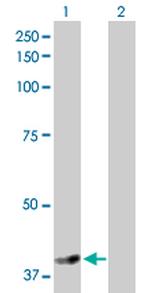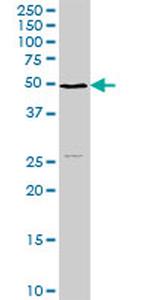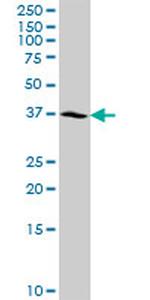Search Thermo Fisher Scientific
FIGURE: 1 / 3
NSDHL Antibody (H00050814-D01P) in WB
Lane 1: NSDHL transfected lysate(41.90 KDa).
Lane 2: Non-transfected lysate.



Product Details
H00050814-D01P
Species Reactivity
Host/Isotype
Class
Type
Immunogen
Conjugate
Form
Concentration
Purification
Storage buffer
Contains
Storage conditions
Shipping conditions
Product Specific Information
Sequence of this protein is as follows: MEPAVSEPMR DQVARTHLTE DTPKVNADIE KVNQNQAKRC TVIGGSGFLG QHMVEQLLAR GYAVNVFDIQ QGFDNPQVRF FLGDLCSRQD LYPALKGVNT VFHCASPPPS SNNKELFYRV NYIGTKNVIE TCKEAGVQKL ILTSSASVIF EGVDIKNGTE DLPYAMKPID YYTETKILQE RAVLGANDPE KNFLTTAIRP HGIFGPRDPQ LVPILIEAAR NGKMKFVIGN GKNLVDFTFV ENVVHGHILA AEQLSRDSTL GGKAFHITND EPIPFWTFLS RILTGLNYEA PKYHIPYWVA YYLALLLSLL VMVISPVIQL QPTFTPMRVA LAGTFHYYSC ERAKKAMGYQ PLVTMDDAME RTVQSFRHLR RVK
Target Information
The protein encoded by this gene is localized in the endoplasmic reticulum and is involved in cholesterol biosynthesis. Mutations in this gene are associated with CHILD syndrome, which is a X-linked dominant disorder of lipid metabolism with disturbed cholesterol biosynthesis, and typically lethal in males. Alternatively spliced transcript variants with differing 5' UTR have been found for this gene.
For Research Use Only. Not for use in diagnostic procedures. Not for resale without express authorization.
References (0)
Bioinformatics
Protein Aliases: bare patches; NAD(P)-dependent steroid dehydrogenase-like protein; Protein H105e3; short chain dehydrogenase/reductase family 31E, member 1; Sterol-4-alpha-carboxylate 3-dehydrogenase, decarboxylating; striated
Gene Aliases: AI747449; Bpa; H105E3; NSDHL; SDR31E1; Str; XAP104
UniProt ID: (Human) Q15738, (Mouse) Q9R1J0
Entrez Gene ID: (Human) 50814, (Mouse) 18194

Performance Guarantee
If an Invitrogen™ antibody doesn't perform as described on our website or datasheet,we'll replace the product at no cost to you, or provide you with a credit for a future purchase.*
Learn more
We're here to help
Get expert recommendations for common problems or connect directly with an on staff expert for technical assistance related to applications, equipment and general product use.
Contact tech support
